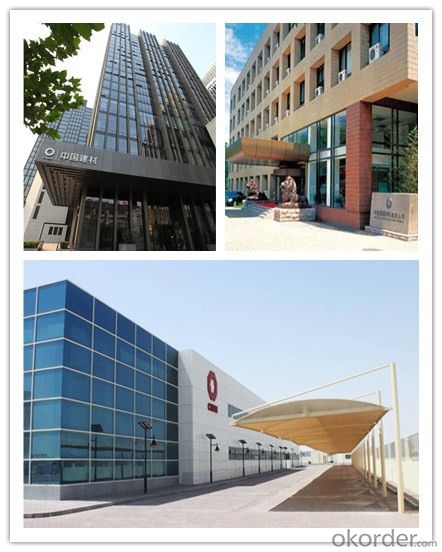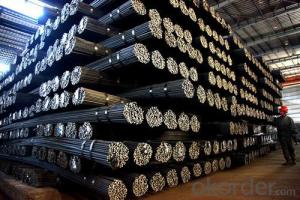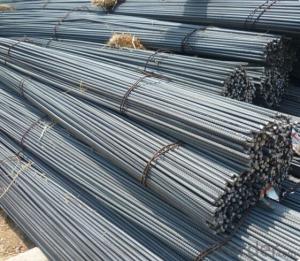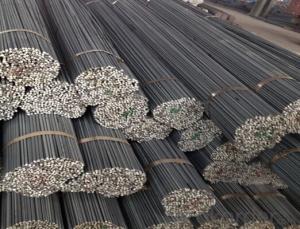Reinforcement Steel Rebar Turkey/Steel Reinforcement
- Loading Port:
- Tianjin
- Payment Terms:
- TT OR LC
- Min Order Qty:
- 100 m.t.
- Supply Capability:
- 10000 m.t./month
OKorder Service Pledge
Quality Product, Order Online Tracking, Timely Delivery
OKorder Financial Service
Credit Rating, Credit Services, Credit Purchasing
You Might Also Like
Item specifice
Standard:
AISI,JIS,GB,BS,DIN,API,EN,ASTM
Technique:
Hot Rolled,Cold Rolled,Cold Drawn,ERW,Forged,Saw,Extruded,EFW,Spring
Shape:
Round,U Channel,Square,C Channel,Hexagonal,Rectangular,Oval,LTZ
Surface Treatment:
Galvanized,Coated,Copper Coated,Color Coated,Oiled,Dry,Chromed Passivation,Polished,Bright,Black,PVDF Coated
Steel Grade:
Q195,Q215,Q235,Q215B,Q235B,RHB335,HRB400,200 Series,300 Series,400 Series,600 Series,SS400-SS490,10#,20#,A53(A,B)
Certification:
ISO,SGS,BV,IBR,RoHS,CE,API,BSI,UL
Thickness:
6-34mm
Width:
6-34mm
Length:
12m
Outer Diameter:
6-34mm
Net Weight:
10kg
Packaging:
seaworthy packaging
Reinforcement Steel Rebar Turkey/Steel Reinforcement
Details of the Reinforcement Steel Rebar Turkey/Steel Reinforcement
| Standard & Grade: | GB1499-98 : HRB335,HRB400,HRB500 |
| BS4449-1997 : GR460,GR500 | |
| CAN/CSA-G30.18-M92 : 400W | |
| ASTM A615 : Gr.40, Gr.60 | |
| Diameter: | 6mm;8mm;10mm;12mm;14mm;16mm;18mm;20mm;22mm;25mm;28mm;30mm;32mm;35mm;40mm |
| Length: | 6m,9m,12m |
| Packing: | Bundle packing |
| Origin: | China |
| Application: | Construction,Road,Machinery processing,Welding fields. |
| Delivery time: | 10-25 days |
| Shipment: | By bulk vessel or Container |
| Documents: | Mill Test Certificate,Commercial Invoice,Packing List,Certificate of Origin |
Company Introduction of the Reinforcement Steel Rebar Turkey/Steel Reinforcement
CNBM International Corporation is the most import and export platform of CNBM group(China National Building Material Group Corporation) ,which is a state-owned enterprise, ranked in 270th of Fortune Global 500 in 2015.
With its advantages, CNBM International are mainly concentrate on Cement, Glass, Iron and Steel, Ceramics industries and devotes herself for supplying high quality series of refractories as well as technical consultancies and logistics solution.


Packaging & Delivery of the Reinforcement Steel Rebar Turkey/Steel Reinforcement
| Packaging Detail | Sea worthy packing /as per customer's packing instruction |
| Delivery Detail | 15 ~ 40 days after receiving the deposit |
FAQ
| Are you a trading company or manufacturer? | Manufacturer |
| What’s the MOQ? | 1000m2 |
| What’s your delivery time? | 15-20 days after downpayment received |
| Do you Accept OEM service? | Yes |
| what’s your delivery terms? | FOB/CFR/CIF |
| What's the Payment Terms? | 30% as deposit,70% before shipment by T/T |
| Western Union acceptable for small amount. | |
| L/C acceptable for large amount. | |
| Scrow ,Paybal,Alipay are also ok | |
| Why choose us? | Chose happens because of quality, then price, We can give you both. Additionally, we can also offer professional products inquiry, products knowledge train (for agents), smooth goods delivery, excellent customer solution proposals. |
| What's your available port of Shipment? | Main Port, China |
| What’s your featured services? | Our service formula: good quality+ good price+ good service=customer's trust |
| Where are your Market? | Covering more than 160 countries in the world |
- Q:What are the common mistakes to avoid while using steel rebars?
- To ensure the structural integrity and safety of a construction project when using steel rebars, it is important to avoid several common mistakes. These mistakes include: 1. Insufficient concrete cover: Corrosion and reduced strength can occur if there is not enough concrete cover over the rebars. It is crucial to maintain the required cover specified in the design throughout the construction process. 2. Improper placement: Placing the rebars incorrectly can result in weak areas within the structure. It is essential to follow the approved drawings, maintaining proper spacing, alignment, and lap lengths. 3. Inadequate anchoring: Inadequate anchoring of the rebars can lead to insufficient load transfer and structural failure. Proper anchoring must be ensured by providing adequate hooks or bends at the ends and using appropriate tie wire or mechanical connectors. 4. Poor welding practices: If welding is necessary to connect rebars, it is crucial to follow proper welding procedures and ensure high-quality welds. Inadequate or improper welding can weaken the rebars and compromise structural strength. 5. Neglecting corrosion protection: Steel rebars are prone to corrosion, particularly in humid or marine environments. Neglecting proper corrosion protection, such as epoxy coating or corrosion inhibitors, can result in premature deterioration and reduced structural performance. 6. Incorrect overlapping of rebars: Overlapping rebars is necessary for the transfer of forces between adjacent sections. However, incorrect overlapping, whether due to insufficient length or improper alignment, can compromise the structural integrity. 7. Lack of inspection and quality control: Failure to conduct regular inspections and quality control checks during the construction process can lead to unnoticed mistakes or deviations from the design. Qualified personnel should inspect the rebars to ensure compliance with specifications and industry standards. By avoiding these common mistakes and following best practices, the construction project's structural integrity and safety can be upheld. Consulting with structural engineers, adhering to approved drawings and specifications, and ensuring proper installation and quality control are essential to prevent potential issues.
- Q:What is the maximum allowable spacing between steel rebars in columns?
- The maximum allowable spacing between steel rebars in columns typically depends on various factors such as the size and type of the rebar, the design requirements, and the local building codes. It is crucial to consult with a structural engineer or refer to the specific building codes and design standards applicable to ensure the appropriate spacing is maintained for structural integrity and safety.
- Q:Can steel rebars be used in bridges?
- Bridges can indeed utilize steel rebars. They are frequently incorporated into concrete structures like bridges to reinforce them. This reinforcement gives the concrete added robustness, enabling it to withstand substantial loads and forces. By employing steel rebars in bridges, their durability and structural integrity are improved, ensuring the safety of both the bridge and its users. Moreover, steel rebars possess exceptional tensile strength, a crucial characteristic for countering the tensile forces bridges commonly encounter. In summary, steel rebars are vital elements in bridge construction, contributing significantly to their strength, longevity, and safety.
- Q:Can steel rebars be used in structures with heavy dynamic loads?
- Yes, steel rebars can be used in structures with heavy dynamic loads. Steel rebars are commonly used in reinforced concrete structures to provide tensile strength and improve the overall structural integrity. They are specifically designed to withstand heavy loads, including dynamic loads such as those caused by vibrations, earthquakes, or moving vehicles. The high tensile strength of steel rebars allows them to absorb and distribute the dynamic loads effectively, preventing structural failure or collapse. Additionally, steel rebars have excellent fatigue resistance, which means they can withstand repeated loading and unloading cycles without losing their strength or integrity. To ensure proper performance under heavy dynamic loads, engineers consider various factors such as the size, shape, and spacing of rebars, as well as the concrete quality and the design of the structure itself. By carefully designing and reinforcing the structure with steel rebars, it is possible to create a safe and durable building that can withstand heavy dynamic loads.
- Q:Are there any specific safety precautions to be taken while handling steel rebars?
- Yes, there are specific safety precautions to be taken while handling steel rebars. Some of these precautions include wearing appropriate personal protective equipment (PPE) such as gloves, safety boots, and eye protection to prevent injuries. It is also important to ensure a safe lifting technique while handling heavy rebars to avoid strains or back injuries. Additionally, workers should be cautious of sharp ends of the rebars and use caution to avoid any cuts or punctures. Regular inspection and maintenance of the rebars is essential to identify any damages or defects that could compromise safety.
- Q:What are the different types of steel rebars used in marine constructions?
- Marine construction commonly utilizes various steel rebars due to their specific properties and resistance to corrosion in saltwater environments. The different types of steel rebars employed in marine constructions are as follows: 1. Stainless steel rebars prove highly resistant to corrosion, making them an ideal choice for marine applications. Their chromium content creates a protective oxide layer on the surface, preventing rust and corrosion. These rebars come in different grades, such as 304 and 316, with 316 being the most commonly used due to its superior corrosion resistance. 2. Galvanized steel rebars, which are carbon steel rebars coated with zinc, act as a barrier against saltwater corrosion. These rebars are cost-effective and widely utilized in marine constructions. 3. Epoxy-coated steel rebars consist of carbon steel rebars coated with epoxy. This coating acts as an effective barrier between the steel and the saltwater environment, providing excellent corrosion protection. Epoxy-coated rebars are commonly employed in marine structures exposed to seawater or other corrosive agents. 4. Fiberglass rebars, made of high-strength glass fibers embedded in a polymer matrix, offer lightweight, non-corrosive alternatives to traditional steel rebars in marine constructions. Additionally, they possess high tensile strength and do not corrode in saltwater environments. 5. Titanium rebars, although more expensive than other steel rebars, are extremely corrosion-resistant and lightweight, making them suitable for marine applications. They are typically used in high-performance marine structures or specific applications where corrosion resistance is crucial. Each type of steel rebar mentioned above possesses unique advantages and limitations. The selection of the appropriate type depends on factors such as project requirements, budget, and environmental conditions. Engineers and designers must consider these factors to ensure the durability and longevity of marine construction structures.
- Q:What are the different types of steel rebars used in beam reinforcement?
- There are several types of steel rebars commonly used in beam reinforcement. These include: 1. Mild Steel Rebars (MSR): These rebars are made from low carbon steel and are widely used due to their affordability and availability. They have a yield strength of 250 MPa and are suitable for general construction purposes. 2. High Yield Strength Rebars (HYSD): These rebars have a higher yield strength compared to mild steel rebars, typically ranging from 415 MPa to 600 MPa. HYSD rebars are commonly used in heavy-duty and high-stress applications, such as bridges and high-rise buildings. 3. Carbon Steel Rebars: These rebars are made from carbon steel, which contains a higher carbon content than mild steel rebars. Carbon steel rebars offer improved strength and ductility, making them suitable for seismic zones and areas prone to corrosion. 4. Stainless Steel Rebars: These rebars are made from stainless steel, which contains a high percentage of chromium and other alloying elements. Stainless steel rebars offer excellent corrosion resistance, making them ideal for structures exposed to harsh environments, such as marine applications or chemical plants. 5. Epoxy-Coated Rebars: These rebars are coated with an epoxy layer to provide additional protection against corrosion. Epoxy-coated rebars are commonly used in structures exposed to moisture or chloride-rich environments, such as coastal regions or areas with deicing salts. It is important to consider the specific requirements and conditions of the project when selecting the type of steel rebar for beam reinforcement. Consulting with structural engineers or industry professionals is recommended to ensure appropriate material selection for optimal performance and longevity of the reinforced beam.
- Q:How do steel rebars impact the overall construction cost estimation process?
- Steel rebars have a significant impact on the overall construction cost estimation process. These reinforcing bars are crucial components in reinforced concrete structures, providing strength and durability to the building. As such, their inclusion in cost estimation is essential for accurately assessing the total project cost. Firstly, steel rebars contribute to the material cost of the construction project. Since rebars are typically priced based on weight, the quantity and size of rebars required for the structure directly affect the material cost estimation. The accurate identification and quantification of rebars are necessary to ensure an appropriate budget allocation for the project. Moreover, steel rebars also influence the labor cost estimation. Installing rebars requires skilled labor, and the time and effort involved in cutting, bending, and placing the rebars must be considered. The complexity of the reinforcement design, such as intricate shapes or complex detailing, can increase labor costs. Therefore, accurate estimation of rebars allows for better planning of labor resources and cost allocation. In addition to material and labor costs, steel rebars impact other aspects of the construction cost estimation process. For instance, the weight and placement of rebars affect the structural design, which can influence the cost estimation of the concrete mix design and formwork requirements. The size and spacing of rebars may also impact the excavation and foundation costs, as well as the overall project timeline. Furthermore, steel rebars contribute to the long-term costs of the construction project. The quality and durability of rebars directly affect the lifespan and maintenance requirements of the structure. Investing in high-quality rebars can reduce future maintenance and repair costs, as well as enhance the overall life cycle cost analysis of the project. In conclusion, steel rebars have a significant impact on the overall construction cost estimation process. Accurate estimation of rebars is essential for determining the material and labor costs, as well as influencing other cost-related aspects of the project. It allows for precise budget allocation, resource planning, and consideration of long-term costs, ultimately leading to a more reliable and comprehensive construction cost estimation.
- Q:What is the maximum allowable stress for steel rebars?
- The maximum allowable stress for steel rebars is typically determined by design codes and standards, which vary depending on the specific application and country. However, in general, the maximum allowable stress for steel rebars is usually around 0.6 times the yield strength of the steel.
- Q:What are the common myths and misconceptions about steel rebars?
- There are several common myths and misconceptions about steel rebars that are important to address in order to have a better understanding of their properties and uses. One common myth is that steel rebars are easily susceptible to rust. While it is true that steel can rust, rebars are typically made with corrosion-resistant materials such as epoxy-coated or galvanized steel. These coatings provide a protective layer that helps prevent rusting, making rebars highly durable and long-lasting even in harsh environments. Another misconception is that larger rebars always provide stronger reinforcement. The size or diameter of a rebar does play a role in its strength, but it is not the only factor. The grade or quality of the steel used, as well as its proper placement within the concrete structure, are equally important. Engineers carefully calculate the required strength and spacing of rebars based on the specific load and structural requirements. Some people believe that steel rebars are only used in large-scale construction projects. However, rebars are commonly used in various construction applications, ranging from residential buildings to bridges and highways. Their versatility and strength make them an essential component in reinforcing concrete structures of all sizes. There is also a misconception that steel rebars increase the risk of electrical conductivity. While steel is a conductor of electricity, the presence of rebars in a concrete structure does not significantly increase the risk of electrical hazards. Concrete acts as an insulator, and rebars are typically encased within it, reducing the likelihood of contact with electrical currents. Lastly, there is a myth that steel rebars are expensive and unaffordable for most construction projects. In reality, the cost of rebars varies depending on factors such as the grade, size, and quantity required. There are various options available to suit different budgets and project needs. Additionally, the long lifespan and durability of steel rebars make them a cost-effective choice in the long run. In conclusion, it is important to dispel the myths and misconceptions surrounding steel rebars. Understanding their corrosion resistance, the role of size and placement, their versatility, the electrical conductivity risks, and their cost-effectiveness will help in making informed decisions when it comes to reinforcing concrete structures.
1. Manufacturer Overview |
|
|---|---|
| Location | |
| Year Established | |
| Annual Output Value | |
| Main Markets | |
| Company Certifications | |
2. Manufacturer Certificates |
|
|---|---|
| a) Certification Name | |
| Range | |
| Reference | |
| Validity Period | |
3. Manufacturer Capability |
|
|---|---|
| a)Trade Capacity | |
| Nearest Port | |
| Export Percentage | |
| No.of Employees in Trade Department | |
| Language Spoken: | |
| b)Factory Information | |
| Factory Size: | |
| No. of Production Lines | |
| Contract Manufacturing | |
| Product Price Range | |
Send your message to us
Reinforcement Steel Rebar Turkey/Steel Reinforcement
- Loading Port:
- Tianjin
- Payment Terms:
- TT OR LC
- Min Order Qty:
- 100 m.t.
- Supply Capability:
- 10000 m.t./month
OKorder Service Pledge
Quality Product, Order Online Tracking, Timely Delivery
OKorder Financial Service
Credit Rating, Credit Services, Credit Purchasing
Similar products
New products
Hot products
Related keywords
































